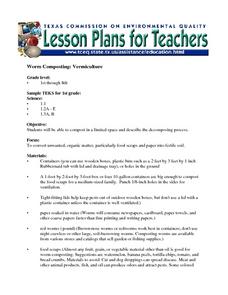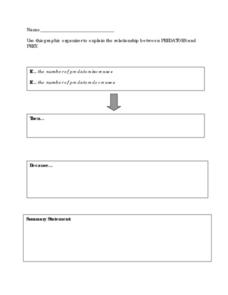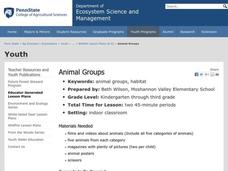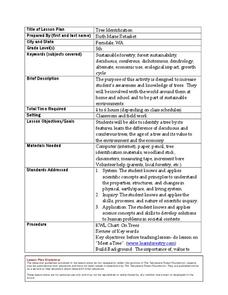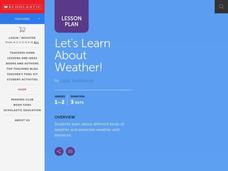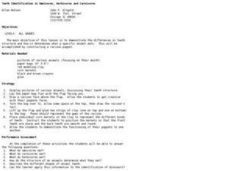Curated OER
What Can We Learn From the X Chromosome?
Learners read about the X and Y chromosomes in humans and complete a worksheet.
Curated OER
More Than a Campground
Fourth graders participate in a class disucssion on the term "habitat". The class brainstorms on what makes a national park special. In small groups, they research a a national park and create a mural depicting those factors that make...
Curated OER
Worm Composting: Vermiculture
Students set up their own composting bin. They observe and record their findings during a period of time. They describe the decomposing process as well.
Curated OER
Criteria and Constraints in Aircraft Design
Students investigate criteria and constraints for designing any aircraft. They define these terms and categorize a series of examples of both. Using the constraints and criteria set before them, they design and construct airplanes in...
Curated OER
Predators and Prey
Students explain how the food chain works. They contrast predators with prey and describe their function in nature. Students discuss how the food chain aids in keeping nature balanced. In small groups, they play a game that simulates the...
Curated OER
Visual Models of Solutions and Concentrations
Students model solutions with beakers of colored glass or plastic spheres. In this solutions lesson, students use beakers of colored spheres to represent pure substances. They mix the spheres to demosntrate solutions. They discuss...
Curated OER
Animal Groups
Learners explore animal groups. In this animal science lesson plan, students use pictures from magazines and classify the animals into five categories. Learners share why they categorized the animals the way they did.
Curated OER
Particle Man and the Photon
Students simulate photon transmission, scattering and absorption. In this physics lesson, students explain why some objects appear bright while others appear dark. They define photon and radiation in their own words.
Curated OER
HAPPY SOIL, SAD SOIL
Young scholars will be able to identify the characteristics of healthy soil and unhealthy soil.Take the class outside to an area of thick grass near trees, if available. Compare the
clothes people wear to the thin cover. Discuss the...
Curated OER
Group Rope Squares
Students study how to better their cohesion and communication skills. In this investigative lesson students work in teams and learn how to communicate better as they help to solve problems and communicate their needs.
Curated OER
Tree Identification
Learners list four ways to identify trees. In this tree identification instructional activity, students use tree identification techniques such as leafs, bark, wood grain, soil type, and climate to create tables and graphs.
Curated OER
Matter: Build a Word
Fourth graders examine matter and the periodic table of elements. In this matter lesson, 4th graders discuss atoms and their composition. Students explore the periodic table of elements and use it to spell words out of the elements.
Curated OER
Seeing Interference Fringes with a Telescope
Students construct an interferometer using a simple telescope. In this physics lesson, students explain how light waves create the fringe patterns. They observe patterns made by different objects in the sky and compare them.
Curated OER
How Long Does Trash Last
Young scholars work in cooperative groups to estimate how long trash lasts in a landfill. They study environmental consequences of not recycling and use graph-making software to create a graph that illustrates the lifespan of trash...
Curated OER
Window Gardens
Learners use a plastic sandwich bag containing a damp paper towel taped to a window as a model system to observe the germination and early growth of radish seeds. They are challenged to pose a question about seed germination and growth...
Curated OER
Let's Learn About Weather!
Learners read several weather-related stories. They brainstorm weather words and use them as they make a weather booklet that includes pictures, a story of their own, and observations they make about the weather outside on that day.
Curated OER
A Habitat Is Home
Young scholars are introduced to the concept and components of a habitat. They discuss the key components of a habitat and describe how certain factors can cause disturbances in a habitat and change its population. Activities are...
Curated OER
Teeth Identification in Omnivores, Herbivores and Carnivores
Young scholars practice identifying teeth. In this biology lesson plan, students explore the differences in teeth structure and how it determines what a specific animal eats by constructing a raccoon puppet.
Curated OER
The Human Body: A Life-Size Model On Paper
Young scholars create a life-size paper model of the human body. They identify the major organs and state their fuction. They complete a quiz to end the lesson.
Curated OER
Predator and Prey Game
Students explore the why the balance among producers, predators and prey is necessary in order for an ecosystem to be sustained over time. Through web games and activities, they discover how each component of the food chain works to...
Curated OER
Earthquake Depth
Students research and locate earthquake epicenters on a map using latitude and longitude. They determine if the depth of an earthquake has any relationship to the distance from a plate boundary.
Curated OER
Hot Air Balloon
Students view a video and discuss the mechanics of a hot air balloon. They, in groups, construct a functioning hot air balloon.
Curated OER
Looking into Surface Albedo
Students demonstrate how the color of materials on Earth affect the amount of solar energy that is absorbed. In this solar energy lesson students complete a lab to explore how the color of materials on the Earth's surface impacts...



